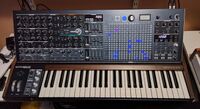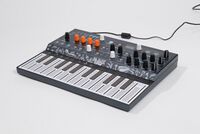Arturia
Topic: Company
 From HandWiki - Reading time: 5 min
From HandWiki - Reading time: 5 min
 | |
| Type | Privately Held Corporation |
|---|---|
| Industry | Software and hardware for musical performance and production |
| Founded | 1999 in Grenoble |
| Founders | Frédéric Brun, Gilles Pommereuil |
| Headquarters | Grenoble |
| Products |
|
Number of employees | 100-199[1] |
| Website | arturia |
Arturia is a French electronics company founded in 1999 and based in Grenoble, France. The company designs and manufactures audio interfaces and electronic musical instruments, including software synthesizers, drum machines, analog synthesizers, digital synthesizers, MIDI controllers, sequencers, and mobile apps.[1]
History
Arturia was founded in 1999 in Grenoble by INPG engineers Frédéric Brun and Gilles Pommereuil to create affordable software synthesizers. Their first product was Storm, a virtual instrument workstation.[2] The close emulation of classic analog synthesizers helped the company gain popularity in its market.[3] Brun and Pommereuil developed new software algorithms that create sounds with minimal digital artifacts.[4]
Arturia worked with Robert Moog in 2003 to create the Modular V softsynth, which uses Arturia's True Analog Emulation (TAE) to faithfully reproduce the oscillators, filters, and other modules from the Moog 3C and Moog 55.[4][5] Following these releases, Arturia developed software emulations of well-known synthesizers, including the ARP 2600, Roland Jupiter-8, Minimoog, and Sequential Circuits Prophet-5. Arturia continues to develop software synthesizers and effects, bundled respectively in the V Collection and FX Collection, which are updated every year.
In 2007, Arturia combined sounds from several of their softsynth titles into Analog Factory, which offered about 2000 preset synthesizer patches,[6] offering this the following year as Analog Experience, a hybrid system which combined the software with a MIDI keyboard controller specifically designed to play and control it.[7]
Arturia entered the hardware synthesizer market in 2009 with the Arturia Origin and followed up in 2012 with the MiniBrute, a vintage-style 25-key monophonic analog synthesizer with one voltage controlled oscillator, two low-frequency oscillators, and a multi-mode Steiner-Parker filter.[8] The synthesizer was introduced at the 2012 NAMM Show.[9] Despite pre-production uncertainty about sales, the MiniBrute sold well due to its low price point and expressive sound.[10] In the following year, Arturia announced their next hardware synthesizer, the MicroBrute, a smaller and less expensive version of the MiniBrute with minikeys, a patch bank, and a sequencer.[11] Both synthesizers received critical acclaim.[10]
In 2015, Arturia launched the AudioFuse.[12] A compact 2-input audio interface with dense connectivity. This was the start of a new line of products which now includes bigger-scale audio interfaces such as the AudioFuse studio, the AudioFuse 8pre and the updated version of the AudioFuse. In 2021, Arturia announced a more affordable line of audio interfaces called MiniFuse, with different number of inputs and colour formats.[13]
In 2016, Arturia released the KeyStep. An entry level 32-note keyboard, acclaimed for its sequencing capabilities and its all round connectivity. This led Arturia to further this line now including the KeyStep pro released at the 2020 NAMM Show,[14] the BeatStep Pro and the KeyStep 37.
Released in 2016 as a part of the Brute family, the Drum Brute is an analog drum machine with a dedicated sequencer. With 17 drum engines, the DrumBrute is known to have a very distinctive sound. Two years later Arturia released the DrumBrute Impact, a shrunk down and reworked version of the DrumBrute with a possibility to add accent to sounds which changes the timbre of each engine.[15]
In January, 2018, they introduced MiniBrute 2. This semi-modular analog synth includes its own tiny patch bay that connects to Eurorack modular gear.[16] They also introduced the MiniBrute 2S which swaps a traditional keyboard for performance pads and a sequencer, more powerful than the MiniBrute 2, that can be recorded in real time.[17]
Released in 2019, MicroFreak is an unusual-looking synthesizer based on a digital oscillator, an analog filter and a touch capacitive keyboard.[18] The digital oscillator allows for different algorithms to be loaded onto the unit, such as physical modelling from mutable instruments or frequency modulation from noise engineering.
In 2020, Arturia released the PolyBrute, its flagship 6-voice-polyphonic analog synthesiser. Its layout is reminiscent of its monophonic counterpart, the MatrixBrute, and shares the same analog architecture as other analog synthesisers from Arturia's Brute range. In addition it features a touchstrip over the keyboard and a multidimensional touchpad called “morphée” which allows more control over the sound.[19]
In 2022, Arturia released the MiniFreak, a polyphonic version of the MicroFreak with a couple more functionalities and a mini key keyboard.[20]
Products
The company's product line includes software synthesizers, software bundles, hardware synthesizers, MIDI keyboards and sequencers, mobile apps, and other audio equipment and controllers.
Arturia sells software instruments and software FX processors as individual items and also as part of the "V" synth collection or the "FX" collection.
Arturia's first instruments were emulations of historical synthesizers, organs, and pianos. Arturia's Analog Lab is a collection of presets of these synths with limited sound modeling available, and comes bundled with many of their Keyboard Midi controllers. In 2018 Arturia released their first original software synthesizer named Pigments. Pigments now features four synthesis types, extensive modulation sources and visual indication of control signals. In 2022 Arturia released a new line of "Augmented" software instruments, which brought new approaches to already known sounds. These Augmented instruments are Voice, Piano, Brass and Strings.
Arturia's first software FX processors were emulations of historical processors, such as preamps and filters. Arturia has since developed original FX processors, such as Rev Intensity, Buss Force, Efx Fragments (granular delay), and Coldfire Distortion.
When Arturia emulates a historical instrument or FX processor, they generally add new functionality such as additional modulation possibilities.
References
- ↑ ”Arturia”, Music Trades Magazine, December 2014, p. 92
- ↑ Courdavault, Adrien (19 January 2015). "Meet the programmers: Arturia" (Interview). MusicRadar. Retrieved 3 February 2015.
- ↑ "Arturia - Musical Instruments Herstellerprofil" (in German). Bonedo. http://www.bonedo.de/artikel/einzelansicht/arturia.html.
- ↑ 4.0 4.1 Pommereuil, Gilles (2 January 2005). "Gilles Pommereuil" (Interview). Interviewed by Cyril Colom. Mixound. Retrieved 3 February 2015.
- ↑ "Arturia Moog Modular V". Vintage Synth Explorer. http://www.vintagesynth.com/misc/mmv.php.
- ↑ Walden, John (January 2007). "Arturia Analog Factory". Sound on Sound. http://www.soundonsound.com/sos/jan07/articles/arturiafactory.htm/.
- ↑ Reid, Simon (July 2008). "Arturia Analog Factory Experience". Sound on Sound. http://www.soundonsound.com/sos/jul08/articles/arturiafe.htm/.
- ↑ "Arturia MiniBrute". Vintage Synth Explorer. http://www.vintagesynth.com/misc/minibrute.php.
- ↑ Rogerson, Ben (19 January 2012). "NAMM 2012: Arturia Minibrute analogue synth announced". MusicRadar. http://www.musicradar.com/news/tech/namm-2012-arturia-minibrute-analogue-synth-announced-524500/.
- ↑ 10.0 10.1 Reid, Gordon (February 2014). "Arturia MicroBrute". Sound on Sound. http://www.soundonsound.com/sos/feb14/articles/arturia-microbrute.htm.
- ↑ Rogerson, Ben (21 October 2013). "Arturia teases new analogue synth; MicroBrute images leaked". MusicRadar. http://www.musicradar.com/news/tech/arturia-teases-new-analogue-synth-microbrute-images-leaked-586471/.
- ↑ Staff, M. P. V.. "macProVideo.com" (in en). https://macprovideo.com/article/audio-hardware/arturia-about-to-release-audiofuse-audio-interface.
- ↑ "Arturia MiniFuse Audio Interfaces Announced" (in en-GB). 28 September 2021. https://www.pro-tools-expert.com/production-expert-1/arturia-minifuse-interfaces-announced.
- ↑ Kane (14 January 2020). "NAMM 2020: Arturia Announces KeyStep Pro" (in en-us). https://www.magneticmag.com/2020/01/namm-2020-arturia-announces-keystep-pro/.
- ↑ "Arturia DrumBrute Impact". https://www.soundonsound.com/reviews/arturia-drumbrute-impact.
- ↑ "Arturia reveal MiniBrute 2 |" (in en-gb). https://www.soundonsound.com/news/arturia-reveal-minibrute-2.
- ↑ "Arturia's MiniBrute 2S synth replaces keys with pads and a sequencer" (in en-US). FACT Magazine: Music News, New Music.. 2018-01-16. http://www.factmag.com/2018/01/16/arturia-minibrute-2s-synth-announced/.
- ↑ Anatomy, Synth (2019-01-29). "Arturia MicroFreak Synthesizer First Look: Unusual But Exciting!" (in en-US). https://www.synthanatomy.com/2019/01/namm-2019-arturia-intros-micro-freak-affordable-hybrid-synthesizer.html.
- ↑ "The Big Review: Arturia PolyBrute" (in en-GB). https://musictech.com/reviews/hardware-instruments/the-big-review-arturia-polybrute/.
- ↑ (in en) Arturia MiniFreak Review // vs MicroFreak // Playing 250+ presets // Pros, cons & full tutorial, https://www.youtube.com/watch?v=D9mZ_Mc2x90, retrieved 2022-12-02
External links
 |
 KSF
KSF

